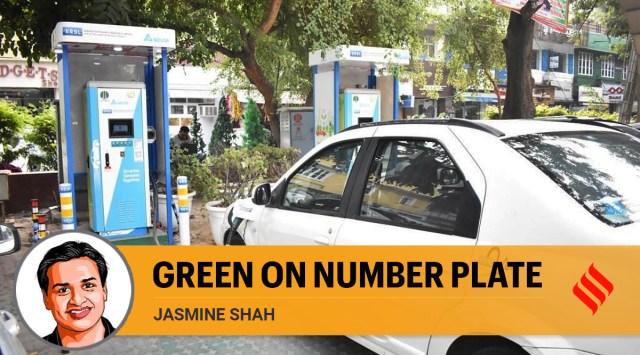
Residents or recent visitors to Delhi may have noticed a sight difficult to find on the streets of other Indian cities — a green number plate on vehicles. As the onset of winter in Delhi and the surrounding states brings with it yet another episode of record AQI levels and narratives of gloom and doom, there is a glimmer of hope after all. The share of electric vehicles (EVs) in Delhi has risen sharply to 9 per cent in the quarter ending November 2021 as against the all-India average of 1.6 per cent, making Delhi the leading state in India in EV penetration.
Several studies have shown that vehicular emissions are among the most significant sources of pollution in Delhi, contributing to a third of all PM 2.5 emissions and over 80 percent of CO2 and NOx emissions — the other two toxic pollutants. Experts agree that a reduction in vehicular pollution will require a mass shift of people to EVs, apart from greater adoption of public and non-motorised transport.
The policy push for EVs began when the Government of India launched the FAME-1 (Faster Adoption and Manufacturing of E-vehicles) scheme to subsidise EVs in April 2015, which was extended in the modified avatar of FAME-2 in April 2019 with a lofty budget outlay of Rs 10,000 crore. The experience, however, has been anything but sober. The central government has barely been able to spend 6 per cent of the FAME-2 budget with the resultant penetration of EVs reaching only 1.6 per cent nationally. So how did Delhi manage to buck this trend?
It was barely a year ago, in August 2020, when Chief Minister Arvind Kejriwal announced Delhi’s EV policy and declared the most ambitious target any Indian state has set — 25 per cent share of EVs by 2024, from a baseline of 1.2 per cent in 2019-20. Born out of the desire to lead by example in finding long-term solutions to the pollution crisis that engulfs much of northern India, the AAP government put out a comprehensive policy framework that — for the first time for any state EV policy in India — focused squarely on demand generation (rather than attracting manufacturing investment) and targeted incentives at the most polluting vehicle segments — two- and three-wheelers.
Fifteen months later, Delhi has managed to turned the tide on EVs by demonstrating a firm political will to address the three key barriers that have plagued the adoption of EVs across India.
Announcing generous subsidies is one thing, making sure citizens can avail of it in a time-bound manner without paperwork or hassles of visiting a government office is quite another. The Delhi government has put in place a completely faceless and online system for transfer of these subsidies directly to the buyer’s Aadhaar-linked bank account within seven days of an EV purchase. A real-time dashboard helps monitor pendency at every step.
The second barrier is the unavailability of charging infrastructure. With a vision of providing public charging within 3 km anywhere in Delhi, the government and Discoms have facilitated setting up 201 charging stations with over 380 charging points across Delhi in the past two years — the highest for any city nationally. Another 600 public charging points are to be added by mid-2022, majority at metro stations and bus depots. The process of setting up private charging points at offices, malls, group housing societies etc. has also been radically simplified. In partnership with the Discoms, Delhi government recently launched India’s first single window facility to install EV chargers faster (within seven days) and cheaper (under Rs 2,500 for a slow charger) than anywhere else in India.
The third barrier was the low public awareness of EVs and its benefits — both economic and environmental. This is where the eight-week Switch Delhi campaign, launched by CM Arvind Kejriwal earlier this year, proved to be a milestone. Delhi became the first state in India to launch such a widespread campaign comprising print, radio, TV ads and targeted outreach to RWAs, youth and corporates. The campaign created a huge buzz on EVs not just in Delhi but the entire country with celebrities such as Kamal Hasan, and the former Environment Minister of Norway, Erik Solheim, taking note.
The experience of Delhi’s EV policy shows that if there is a political will to fight pollution, creating comprehensive reform roadmaps and following them up with diligent implementation, the “Yuddh Pradushan ke Viruddh” can be won. But this war cannot be won by Delhi alone — which occupies barely 3 per cent of the land area of NCR. Delhi has shown the way, but unless all NCR states show a similar resolve and emulate the actions Delhi has taken to transition to clean mobility, we will be cursed to gloom and doom scenarios for years to come.
This column first appeared in the print edition on December 13, 2021 under the title ‘Green on number plate’. Shah is vice chairperson, Dialogue and Development Commission of Delhi